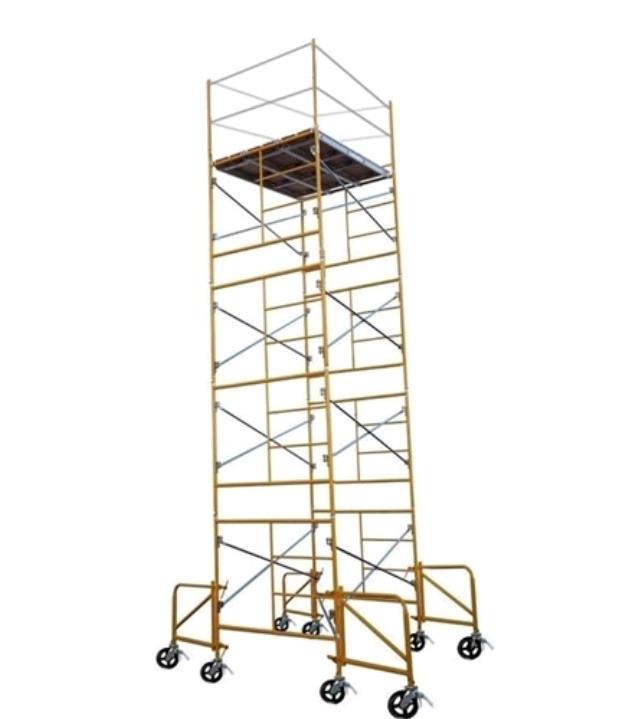
Section 1926.452(w)(6) specifies requirements for moving a scaffold while an employee is on it.
#Scaffold wheels in shawnee ok manual#
Section 1926.452(w)(3) and 1926.452(w)(6)(iv) address the manual and powered forces used to move the scaffold. However, there are other requirements that must be met where an employee is on (and moves) a scaffold, and they must be met as well. If a device were installed to permit the casters to be locked while on a scaffold, this particular requirement could be met without dismounting the scaffold. (This section would not apply to workers manually moving a scaffold.) Īs we explained in the Holman letter, 1926.452(w)(2) requires that mobile scaffold casters and wheels be locked to prevent scaffold movement when in use. When using a power system to move the scaffold, the forces must be applied directly to the wheels. Since the force being applied to the scaffold is less than 5 feet from the ground level, this is acceptable as long as it is the lowest point practicable. The worker holds onto something overhead and moves the scaffold with his or her feet. Your letter describes a worker standing on a Baker scaffold that is 2 to 4 feet high. When manually moving the scaffold, the force should be applied as close to the base a practicable, but not more than 5 feet (1.5m) above the supporting surface. These sections address the manual and powered forces used to move the scaffold. Where these conditions are met, the scaffold may be moved while employees are on it. Section 1926.452(w)(6) specifies the requirements for riding a scaffold. If a device were installed to permit the casters to be locked while on the scaffold, this requirement could be met without dismounting. Section 1926.452(w)(2) requires the casters and wheels to be locked when in use.

We apologize for the delay in this response.īaker scaffolds, sometimes referred to as Perry scaffolds, are covered by the mobile scaffold section of subpart L. In the Holman letter, we stated: Your questions related specifically to Baker style scaffolds and whether a person could move and work from this type of scaffold without dismounting, with the casters in the unlocked position.

In your April 8 letter and telephone conversations with my staff, you have submitted court documents and have described two accidents that you assert are illustrative of your assertion. Specifically, you assert that the guidance we provided in the letter is contrary to the manufacturers' instructions on their use and is not safe. The type of scaffold in question is commonly referred to as a "Perry" or "Baker" scaffold. This issue was addressed in OSHA's letter to Mr. Question: The issue you raise concerns an OSHA interpretation letter regarding whether OSHA construction standards allow employees to stay on a certain type of scaffold with the casters in the unlocked position. We apologize for the delay in responding to your request. This is in response to your December 26, 2001, and April 8, 2002, letters addressed to the Occupational Safety and Health Administration (OSHA) and a subsequent phone conversation with a member of my staff, Mr. Casters are only one of the many items we carry we also have frames, walk boards, side-brackets, safety equipment, and much more. You’ll find such wheels here at ScaffoldMart.Īs a leader in the scaffolding industry, you can expect us to have all the accessories for your scaffolding. Scaffolding casters should have secure brakes, heavy-duty components to withstand loads, and grease fittings to keep them running smoothly. While there are cheap options that might do the job in the short term, they may lack the features that provide durability – which make for a good investments. These workhorse wheels must last without fault.

When it comes to caster wheels, it’s better to prioritize quality over savings. The polycarbonate version is lighter and resists marking with only slightly less load capacity, but they cost a little bit more. Our cast-iron wheels are heavily built, they are tough. Rest assured, we only offers products that will serve you well for a long time. We have two kinds of wheels for scaffolding in stock: cast-iron and polycarbonate. If your business frequently uses scaffolding for work, we’ve got the caster wheels needed to get the job done. It can be very heavy, the ability to add casters and move it let’s contractors do jobs in significantly less time. Mobility can be important for scaffolding.


 0 kommentar(er)
0 kommentar(er)
